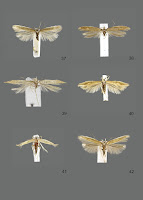Abstract
The subgenus Pseudomegachile Friese of the large genus Megachile Latreille is revised for the Western Palaearctic region, Iran, and the Arabian Peninsula. Twenty species are recognized, of which five are new: Megachile blepharis Dorchin & Praz from Israel, M. plumigera Dorchin & Praz from Oman and the United Arab Emirates, M. syriaca Dorchin & Praz from Syria and Turkey, M. yezidica Dorchin & Praz from Turkey and Iran, and M. maxschwarzi Dorchin & Praz from Iran and Central Asia. The following new synonymies are proposed: M. inermis Radoszkowski 1893 (as well as the replacement name M. mitis Cockerell 1899), M. albifasciata Rebmann 1970 and M. transgrediens Rebmann 1970 are placed in synonymy with M. saussurei Radoszkowski 1874; M. tuberculata Radoszkowski 1893 (as well as the replacement name M. tuberculosa Dalla Torre 1896) is placed in synonymy with M. seraxensis Radoszkowski 1893; M. rubripes Morawitz 1875 and M. persica Rebmann 1972 are placed in synonymy with M. flavipes Spinola 1838; M. stolzmanni Radoszkowski 1893 and M. flavidula Rebmann 1970 are placed in synonymy with M. tecta Radoszkowski 1888. Lectotypes are designated for M. cinnamomea Alfken 1926, M. nilotica Pérez 1897, M. inermis, M. seraxensis, M. tuberculata, M. farinosa Smith 1853, M. derasa Gerstäcker 1869, M. erythrocnemis Alfken 1930 and M. xanthocnemis Alfken 1938. An identification key is provided, a phylogenetic hypothesis including most species in the subgenus is presented, and the biology of the species is briefly summarized.
Keywords: Hymenoptera, Apiformes, Arabian, Chalicodoma, dauber bees, Mediterranean, mason bees, nesting biology, phylogeny, pollen host, trap nest
Achik Dorchin and Christophe J. Praz. 2018. Taxonomic Revision of the Western Palaearctic Bees of the Subgenus Pseudomegachile (Hymenoptera, Apiformes, Megachilidae, Megachile). Zootaxa. 4524(3); 251–307. DOI: 10.11646/zootaxa.4524.3.1
![]()
The subgenus Pseudomegachile Friese of the large genus Megachile Latreille is revised for the Western Palaearctic region, Iran, and the Arabian Peninsula. Twenty species are recognized, of which five are new: Megachile blepharis Dorchin & Praz from Israel, M. plumigera Dorchin & Praz from Oman and the United Arab Emirates, M. syriaca Dorchin & Praz from Syria and Turkey, M. yezidica Dorchin & Praz from Turkey and Iran, and M. maxschwarzi Dorchin & Praz from Iran and Central Asia. The following new synonymies are proposed: M. inermis Radoszkowski 1893 (as well as the replacement name M. mitis Cockerell 1899), M. albifasciata Rebmann 1970 and M. transgrediens Rebmann 1970 are placed in synonymy with M. saussurei Radoszkowski 1874; M. tuberculata Radoszkowski 1893 (as well as the replacement name M. tuberculosa Dalla Torre 1896) is placed in synonymy with M. seraxensis Radoszkowski 1893; M. rubripes Morawitz 1875 and M. persica Rebmann 1972 are placed in synonymy with M. flavipes Spinola 1838; M. stolzmanni Radoszkowski 1893 and M. flavidula Rebmann 1970 are placed in synonymy with M. tecta Radoszkowski 1888. Lectotypes are designated for M. cinnamomea Alfken 1926, M. nilotica Pérez 1897, M. inermis, M. seraxensis, M. tuberculata, M. farinosa Smith 1853, M. derasa Gerstäcker 1869, M. erythrocnemis Alfken 1930 and M. xanthocnemis Alfken 1938. An identification key is provided, a phylogenetic hypothesis including most species in the subgenus is presented, and the biology of the species is briefly summarized.
Keywords: Hymenoptera, Apiformes, Arabian, Chalicodoma, dauber bees, Mediterranean, mason bees, nesting biology, phylogeny, pollen host, trap nest
Achik Dorchin and Christophe J. Praz. 2018. Taxonomic Revision of the Western Palaearctic Bees of the Subgenus Pseudomegachile (Hymenoptera, Apiformes, Megachilidae, Megachile). Zootaxa. 4524(3); 251–307. DOI: 10.11646/zootaxa.4524.3.1














































































